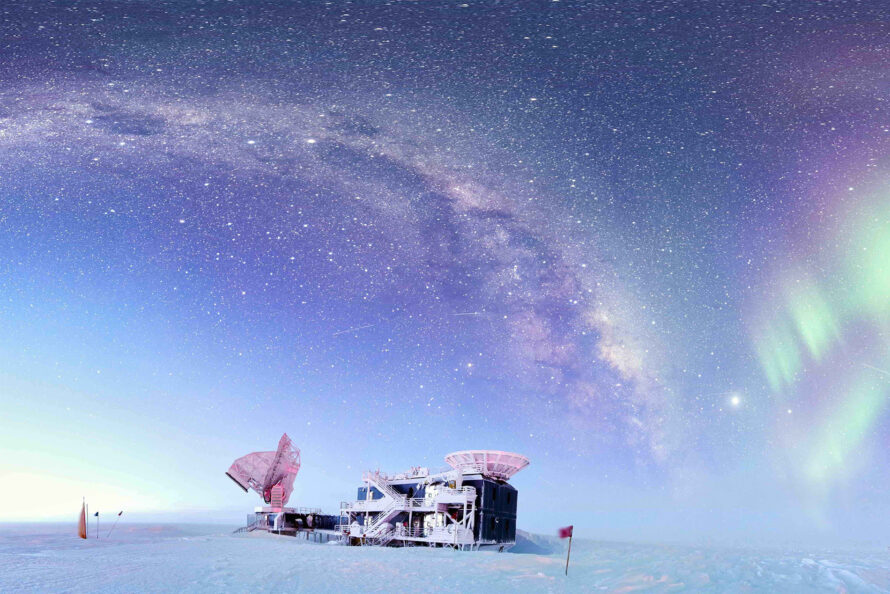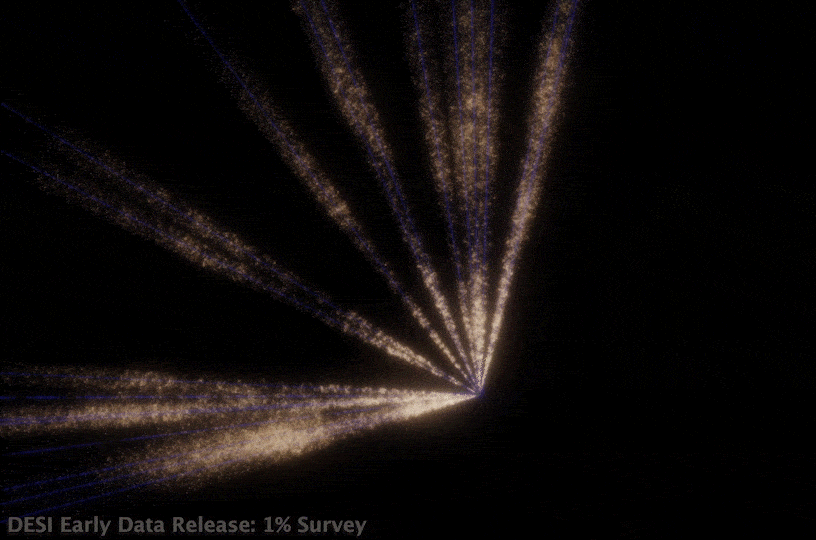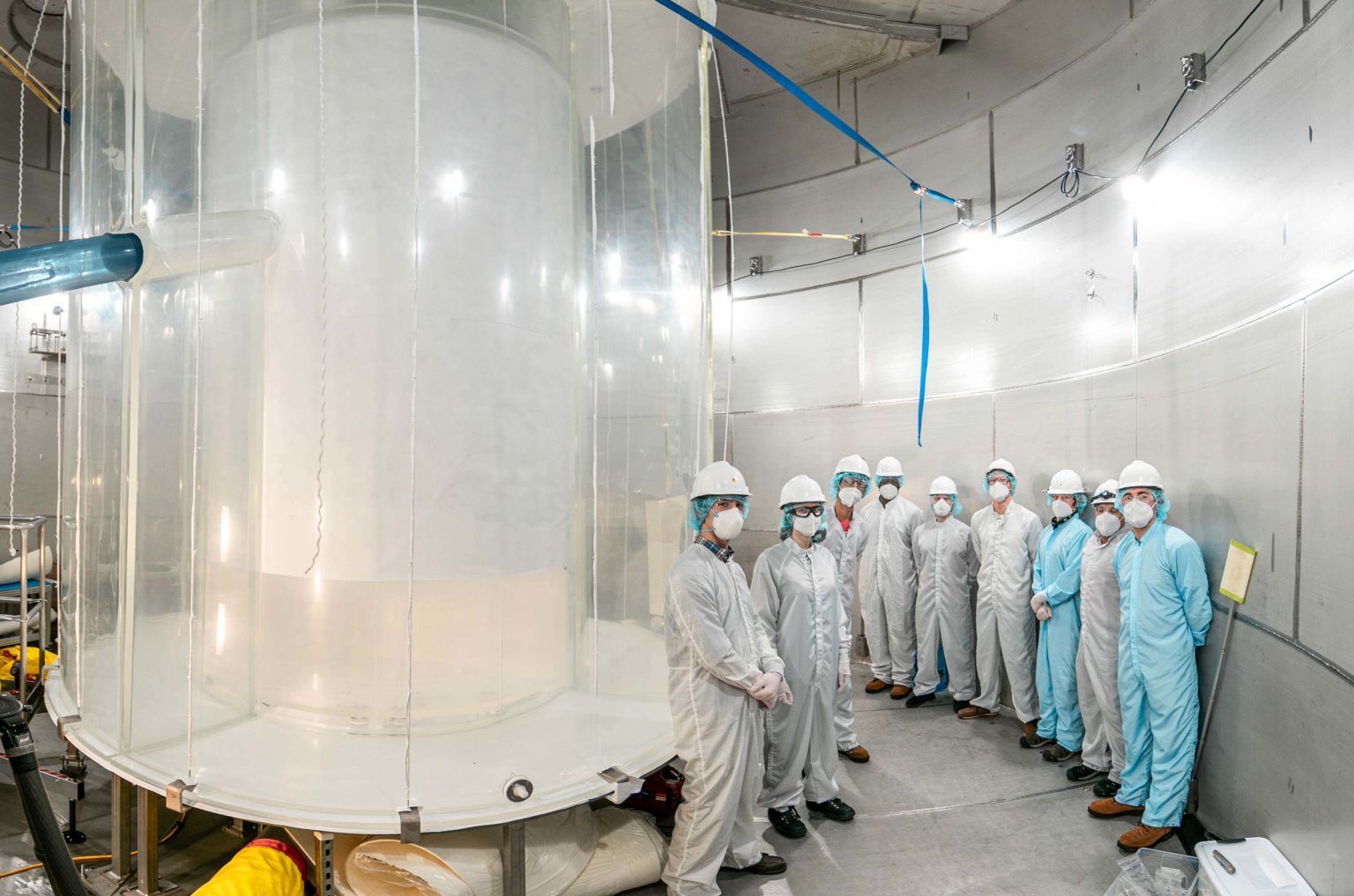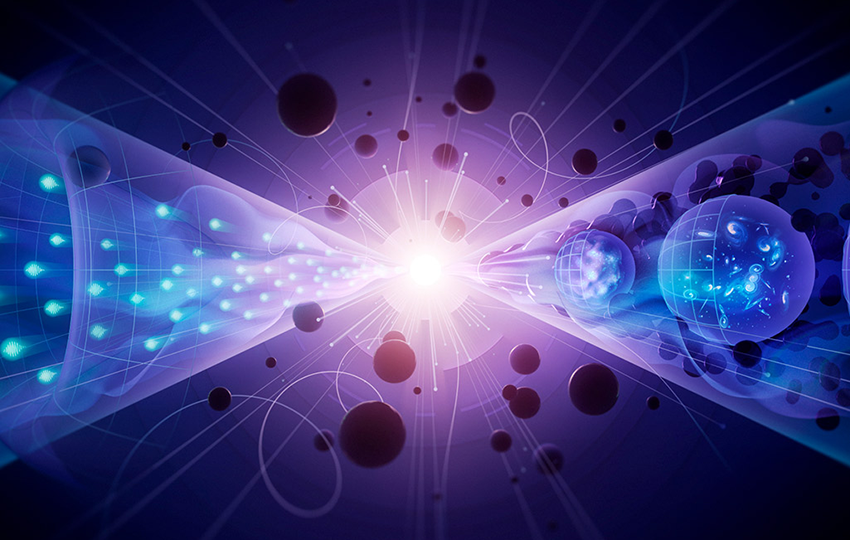The much-anticipated 2023 Particle Physics Project Prioritization Panel (P5) Report, which outlines particle physicists’ recommendations for the next decade, was accepted on December 8 by the High Energy Physics Advisory Panel (HEPAP), which advises the U.S. Department of Energy’s Office of High Energy Physics (HEP) and the National Science Foundation’s Mathematical & Physical Sciences Directorate (MPS).
Lawrence Berkeley National Laboratory’s (Berkeley Lab) research and capabilities are well aligned with the new recommendations, which confirm support for several current large-scale efforts and expand on others. The 2023 report “provides an inspirational vision for the future of particle physics and cosmology,” said Natalie Roe, Berkeley Lab’s Associate Laboratory Director for Physical Sciences, who added, “The committee had to make hard choices under constrained budget scenarios. Berkeley Lab’s research program is well-positioned to support this roadmap, which recommends the CMB-S4 project and future dark energy and dark matter experiments, as well as the expansion of support for accelerator R&D to enable future high energy colliders.”
“Berkeley Lab’s research program is well-positioned to support this roadmap, which recommends the CMB-S4 project and future dark energy and dark matter experiments, as well as the expansion of support for accelerator R&D to enable future high energy colliders.”
– Natalie Roe
The report, entitled Exploring the Quantum Universe: Pathways to Innovation and Discovery in Particle Physics, is a foundational document that advances the scientific priorities identified by the “Snowmass” Community Study on the Future of Particle Physics, which was completed in 2022 and distilled contributions from thousands of scientists into a set of consensus recommendations. The P5 report is book-ended by a recent report from the HEPAP International Benchmarking Subpanel and a forthcoming National Academies study, Elementary Particle Physics: Progress and Promise. The last P5 Report, Building for Discovery: Strategic Plan for U.S. Particle Physics in the Global Context, was issued in 2014.
Hitoshi Murayama, a theoretical physicist in Berkeley Lab’s Physics Division and the MacAdams Professor of physics at the University of California, Berkeley, chaired the P5 Committee, and Cameron Geddes, director of Berkeley Lab’s Accelerator Technology & Applied Physics (ATAP) Division, was a committee member. Murayama and the P5 Deputy Chair, Karsten Heeger of Yale University, made a presentation to HEPAP in Washington, DC, on December 7 that summarized the P5 Report recommendations. The report identified three overarching science themes, each with two focus areas, or science drivers, that they recommended as the most promising avenues of investigation for the next 10-20 years. The report includes a range of budget-conscious recommendations for federal investments in research, the U.S. technical workforce, and the technology and infrastructure needed to realize the next generation of transformative discoveries related to fundamental physics and the origin of the universe.
New knowledge, and new technologies, set the stage for the Panel’s new recommendations. “The Higgs boson had just been discovered before the previous P5 process, and now our continued study of the particle has greatly informed what we think may lie beyond the standard model of particle physics,” said Murayama said in the American Physical Society’s press release. “Our thinking about what dark matter might be has also changed, forcing the community to look elsewhere — to the cosmos. And in 2015, the discovery of gravitational waves was reported. Accelerator technology is changing too, which has shifted the discussion to the technology R&D needed to build the next-generation particle collider.”
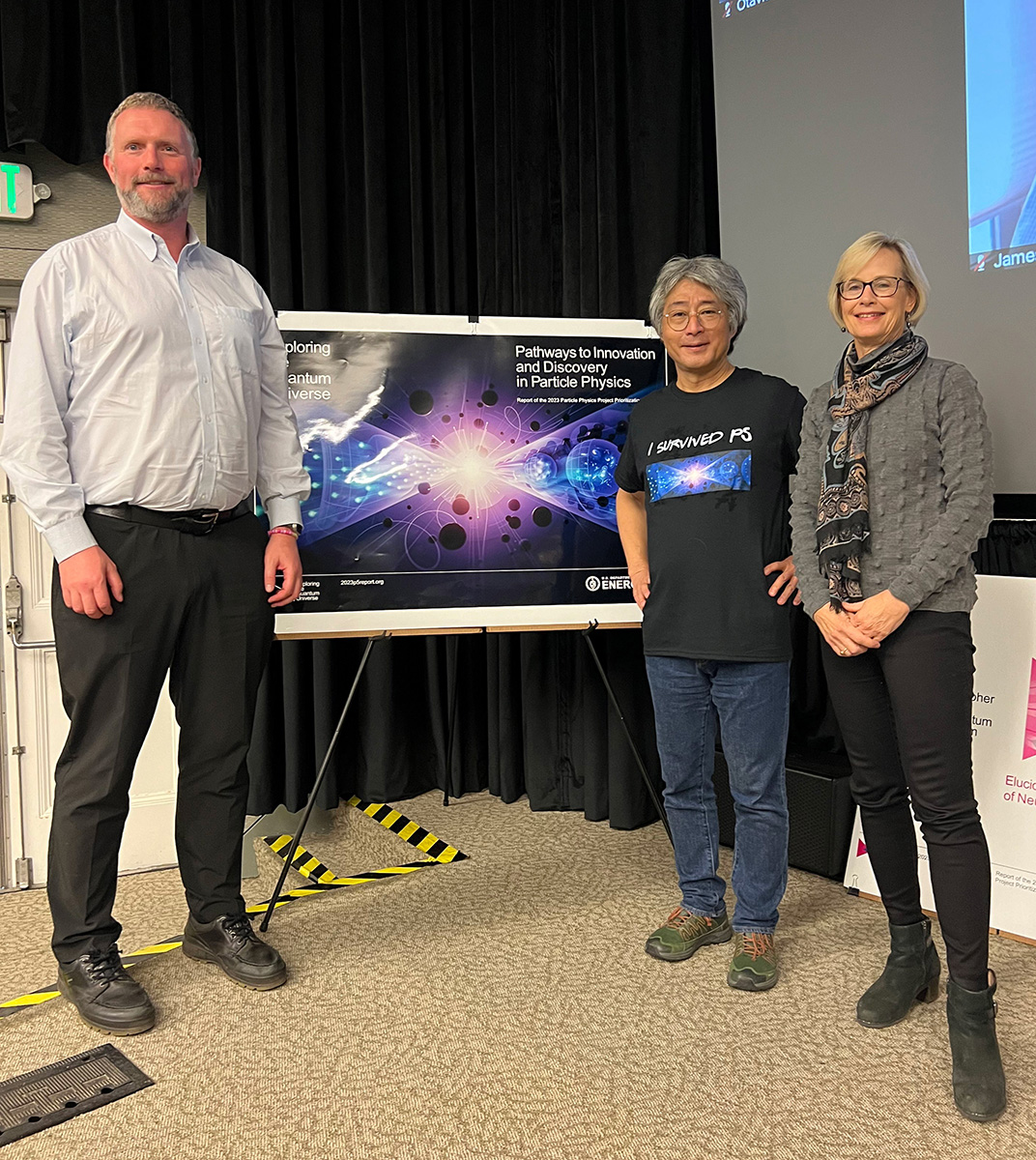
Cameron Geddes, Hitoshi Murayama, and Natalie Roe after Murayama’s P5 Report presentation at Berkeley Lab on December 12, 2023. (Credit: Stephany Tone)
P5’s first recommendation was to continue support for the current program launched by the previous P5 report in 2014, including the high luminosity Large Hadron Collider (LHC) detector and accelerator upgrades, phase one of the DUNE (the Deep Underground Neutrino Experiment) and PIP-II projects, and the Vera Rubin observatory. Continued operation of smaller projects also received the panel’s endorsement, including Berkeley Lab-led projects DESI (the Dark Energy Spectroscopic Instrument) and LZ (the LUX-ZEPLIN dark matter experiment).
The second P5 recommendation concerned major (>$400M) new construction projects, with the top priority going to CMB-S4 (the Cosmic Microwave Background Experiment – Stage 4), a next-generation experiment being pursued as a joint DOE and NSF project to precisely map the cosmic microwave background with unprecedented sensitivity. Berkeley Lab is leading the DOE portion of the CMB-S4 project, in close partnership with the University of Chicago which leads the NSF portion. As described in the report, CMB-S4 “is the transformative next-generation CMB experiment, with the ambitious primary science goals of constraining the energy scale of inflation and determining the abundance of light relic particles in the early universe. CMB-S4 will also measure the sum of neutrino masses and probe the physics of dark matter and dark energy, in addition to a rich and exciting astrophysics program.” CMB-S4 Project Director Jim Strait said, “We are gratified that P5 has re-affirmed the importance of the science of CMB-S4 and has given it top priority in the list of new major projects. We are eager and committed to build CMB-S4 and deliver transformative scientific discoveries.”
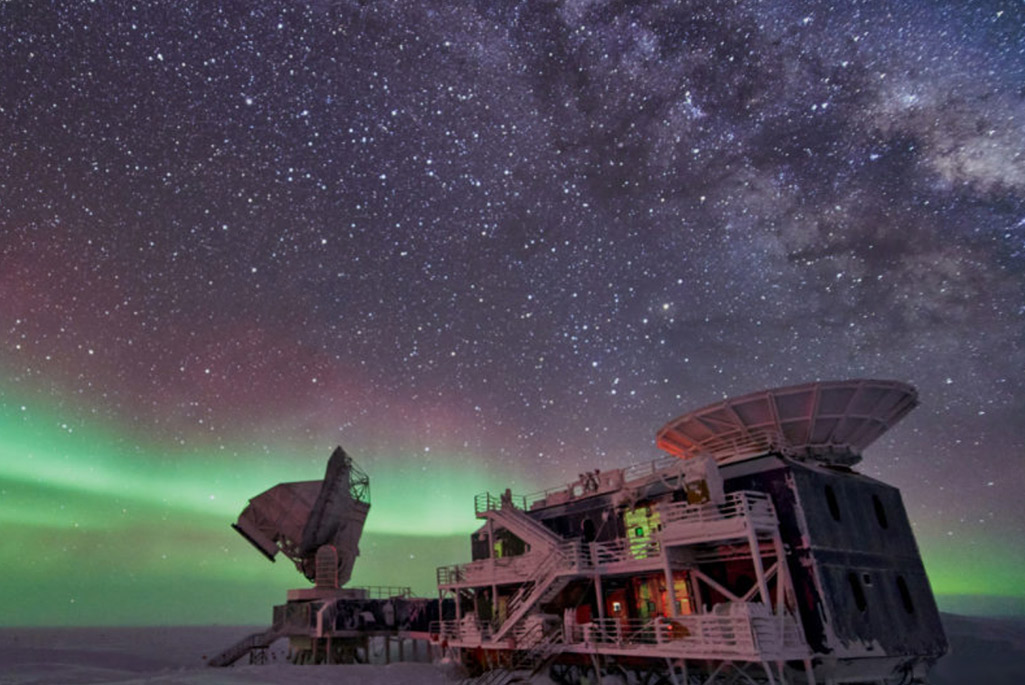
For CMB-S4, a new set of telescopes will be built to map the light from the aftermath of the Big Bang in greater detail than ever before. The instruments will be installed at the South Pole, shown here, and in Chile. (Credit: Geoff Chen)
The panel’s second-ranked major project is a re-envisioned second phase of DUNE – including a third far detector, an upgraded near detector, and an upgraded accelerator at FNAL – which will further expand DUNE’s power and scope as a neutrino laboratory. Berkeley Lab plans to continue its involvement in the DUNE project, where it is currently leading the technical work on the phase one near detector and associated infrastructure, as well as aspects of the far detector readout electronics and the data analysis software.
To conduct precision studies of the most recently discovered fundamental particle, the Higgs boson, the panel’s third-ranked priority is to create a vision for significant U.S. participation in an off-shore Higgs factory, to which Berkeley Lab researchers would plan to contribute on several fronts including the accelerator and the detector, just as they are currently contributing to the ATLAS detector and high-luminosity LHC accelerator upgrades. As a follow-on to the LZ experiment, Berkeley Lab is also involved in a proposal for the panel’s 4th-ranked Generation 3 (G3) dark matter direct detection experiment, to be developed in coordination with international partners and preferably sited in the U.S.
The third recommendation of the panel was to improve the balance of small-, medium-, and large-scale projects in the U.S. particle physics research portfolio. This recommendation included support for a continuation of DESI, dubbed DESI-II, as a pathfinder towards a future larger spectroscopic redshift survey called Spec-S5, proposed by Berkeley Lab, which was recommended for R&D funding. Under the more favorable budget scenario, an early construction start for Spec-S5 was also foreseen. In addition, P5 recommended a new small project portfolio that would include enhanced support for smaller-scale dark matter experiments such as TESSERACT, a Berkeley Lab-led experiment that would search for light dark matter particles.
Nathalie Palanque-Delabrouille, director of Berkeley Lab’s Physics Division, said, “I am enthusiastic at the prospect of implementing the vision laid out by P5. As lead lab for DESI, LZ, and CMB-S4, we have a very strong cosmology program, which now has a bright future ahead of it with the support for the next-generation projects that the report recommends. In the next decade, continuation of our work on DUNE and future particle colliders will also be key in our quest to explore the quantum universe.”
To reinforce the country’s leading role in international high energy physics for decades to come, P5 also recommended that the U.S. research community study future advanced facilities including a high energy and cost-effective 10 TeV parton-center-of-mass collider, motivated by the prospect of discovering new physics and requiring transformative accelerator technology based on proton, muon, or possible wakefield technologies. Included in this recommendation is an evaluation of a possible U.S. location for this new machine, with an aim to be ready to build major test and demonstrator facilities advancing key technology within the next 10 years.
The report included strong support for more aggressive accelerator research and development, including increases in general accelerator R&D, support for accelerator test facilities, and targeted collider studies as well as updates to the Fermilab accelerator complex. Berkeley Lab’s broad-ranging accelerator science program supports each of these directions for the future of the field. Berkeley Lab leads the U.S. Magnet Development Program, which develops new approaches to superconducting magnet technology, a key component for any future energy frontier collider. Accelerator simulations, such as those developed by the ATAP Division’s Accelerator Modeling Program (AMP), are another important capability that will be critical in the design of future accelerators as are controls and RF systems developed by the Berkeley Accelerator Controls and Instrumentation (BACI) Program.
Berkeley Lab is a leading center for research on laser plasma wakefield acceleration, a potentially transformative accelerator technology that can reach acceleration gradients much higher than conventional techniques. Going forward, there are plans to maximize the use of test facilities like the Berkeley Lab Laser Accelerator (BELLA) Center which are identified in the report as “ever more important to develop the advanced technology for future machines.” Development of new test facilities including Berkeley Lab’s kBELLA Initiative for projects this decade is planned, which was also identified as a path to improve performance and lower the cost of future accelerators.
“The inspirational opportunities for particle physics described in the report place radical new demands on accelerator capabilities,” said Geddes, who also stated, “We look forward to developing the capabilities emphasized in the report based on our broad leadership in accelerators, from a near-term Higgs factory to Fermilab complex improvements, to revolutionary technology for proton, wakefield, and muon paths to new frontiers in collider energy.”
###
Lawrence Berkeley National Laboratory (Berkeley Lab) is committed to delivering solutions for humankind through research in clean energy, a healthy planet, and discovery science. Founded in 1931 on the belief that the biggest problems are best addressed by teams, Berkeley Lab and its scientists have been recognized with 16 Nobel Prizes. Researchers from around the world rely on the Lab’s world-class scientific facilities for their own pioneering research. Berkeley Lab is a multiprogram national laboratory managed by the University of California for the U.S. Department of Energy’s Office of Science.
DOE’s Office of Science is the single largest supporter of basic research in the physical sciences in the United States, and is working to address some of the most pressing challenges of our time. For more information, please visit energy.gov/science.
